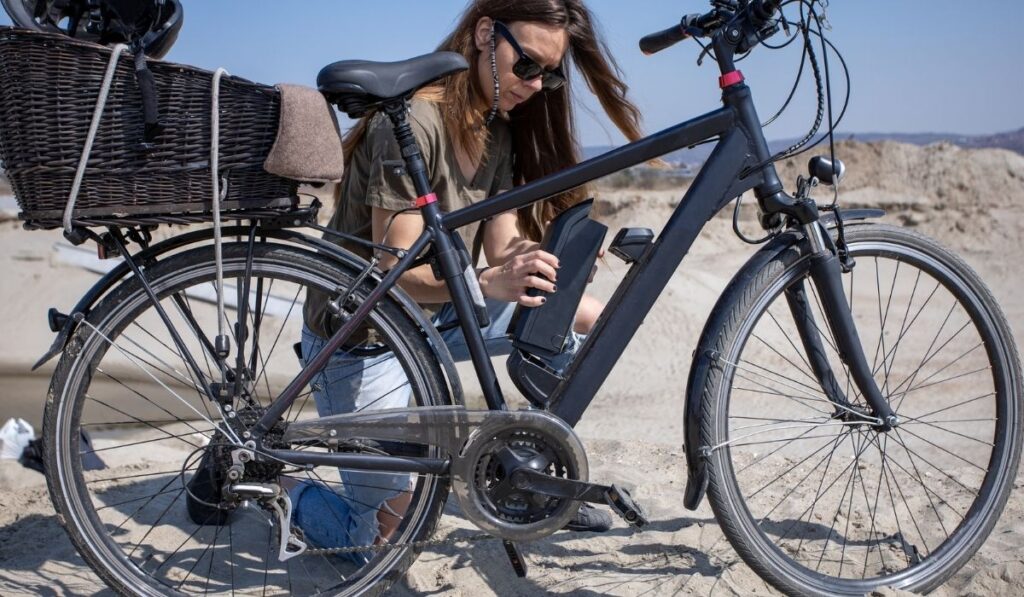We all want to reduce our carbon footprint. For most of us, that means adjusting some easy-to-manage areas of our lifestyle. For example, reducing plastic use or following a vegan diet. Instead of gas-guzzling cars, thousands of environmentally conscious people are opting for e-bikes instead. But do these electric bikes have a carbon footprint of their own that the eco-conscious need to worry about?
Electric bikes have a minimal carbon footprint. They typically produce 2.5 to 5 grams of carbon dioxide per mile. Compare that to cars which produce around 8,000 grams of carbon per gallon of gas burned (40-160 grams per mile). E-Bikes can also have very long lifespans, operating for years on end just like cars.
If you’re looking to cut your carbon footprint, an e-bike is a great way to do it. Not only do they give you the best bang for your buck when it comes to reduced emission transportation, but they also don’t require you to work that hard to get from A to B. This means that you won’t be arriving at work all sweaty, which is always a bonus. Ready to learn more about e-bikes and their carbon footprint? Read on!
The Carbon Footprint of E-Bikes compared to Cars

Okay, so you’re ready to get pedaling, but how does the carbon production of your electric two-wheel compare to a gas-guzzling sedan? If you’ve environmentally conscious, this is probably a question you’re burning to know the answer to. So, what gives? You can probably safely assume that e-bikes have lower carbon emissions overall. But by how much exactly?
While you might hope that the answer is none, sadly, it’s just not that simple. Sure, you may be cutting out the everyday carbon dioxide produced by your daily commute, but there is more than just riding your e-bike that impacts the environment. So while you’re getting a lot of good miles out of your e-bike without directly polluting the environment, let’s explore, in relation to cars, how e-bikes fare for the environment.
What’s the Carbon Footprint of an E-Bike?
Look, no matter which way you cut it, your e-bike does a much better job than a car in regards to pollution and carbon emissions. But to get a clear picture of the total environmental impact, we have to go all the way back to the metal in the ground used for manufacturing.
Think about it, that e-bike doesn’t just magically appear at your doorstep. It gets there by car, train, truck, and sometimes even boat. All those modes of transport emit extra carbon into the atmosphere. Moreover, the costs of mining the ore used for the metal in your bike also play a role in the overall carbon footprint.
But before you think it’s all doom and gloom, remember we are comparing e-bikes to cars. So while the environmental damage of manufacturing and logistics certainly adds up, this goes for pretty much anything you buy that wasn’t grown and produced locally. This applies to cars, too, meaning that your e-bike’s environmental impact is negligible in comparison.
Are E-Bikes Carbon Neutral?
Carbon neutral is a nice term, but what does it mean exactly? Well, it means simply that a product produces zero carbon. For some companies, however, this also means counterbalancing carbon emissions with carbon saving practices. So, in a way, anything can be carbon neutral.
For example, we all know that coal is a massive impediment to achieving a carbon-free world. But, in theory, a company could call their coal “carbon neutral” if they balanced the carbon it produces by creating carbon sinks to counteract this. So theoretically, you can achieve “carbon-neutral” coal.
E-bikes, as we discussed before, are not necessarily carbon neutral due to manufacturing and transportation practices to distribute the product. Some companies try to balance this out with carbon reduction practices, but not all.
If you do worry about the environmental impact of your shopping choices, we recommend that you always do your research and find a company that advertises itself as sustainable. This is the best way to make sure the impact of your e-bike is counteracted by other carbon-reducing practices.
What’s the Carbon Footprint of a Typical Car?
So we’ve talked about e-bikes, and you already know they are better for the environment than cars. But, let’s put figures to our ideas.
Typically, an average car produces around 4.6 metric tons of carbon a year. This will depend heavily on where you are geographically and what type of car you have. Modern cars are vastly more efficient than older models, but still have an impact on the environment nonetheless.
If you have to source a car, make sure you try and find fuel-efficient, hybrid, or even electric cars. You will always face some sort of impact when making a purchase and driving, but you can mitigate a lot of these costs by making informed choices.
How Long Do E-Bikes Last (Compared to Cars)?
So, once you’ve decided that an e-bike is in fact the right choice for you, what can you expect in terms of lifespan? This is a great question as the majority of carbon costs come from manufacturing. So if you need to purchase a new bike too often, you’ll still be racking up your carbon emissions.
Your average e-bike will last around 5-7 years. Of course, this depends on a few factors like environment, build quality, materials used, how often you ride it, etc. Always make sure that you are properly charging your battery to guarantee the best lifespan from your e-bike. Cars can last almost forever — with proper maintenance of course.
Over time, e-bike parts will wear and need replacing with extended use. In most cases, this will be your average bike parts like brake pads and chains. Every so often, a part of the motor drivetrain might fail. This will cost more to fix but still shouldn’t break the bank. Motors that have better protection will of course last the longest, so keep that in mind when shopping for models.
How Often Should E-Bike Batteries Be Replaced?

We already know that the most consequential part of an e-bike is the battery. They provide the juice you need to keep moving. Without the battery, well, you don’t have an e-bike, now do you? So what can you expect a few years down the line? Will you need to replace that battery often?
Yes, you will inevitably need to replace your e-bike battery at some point. Most manufacturers make bikes in a way that the battery can be easily accessed for replacement. While most batteries will last quite a while, at some point, they will start to degrade and fail.
The best way to gauge your battery is through charging cycles. Most batteries have a lifespan of around 1000 charges. But that doesn’t mean 1000 times using the charger; it means 1000 cycles. Let us explain: if you drain your battery to 70%, then charge to 100%, that’s only 30% of a cycle and not a complete cycle. So, in reality, your battery will most likely last quite a bit longer than you expect.
How do you Recycle E-Bike Batteries?
So what do you do when your battery is dead? If you’ve got 1000 cycles out of it and are ready to upgrade, you’ll want to recycle that battery. Since most batteries are made of lithium-ion, it means they can easily be recycled.
To recycle your e-bike battery, you’ll need to find a certified battery recycling center. Since Li-ion is a very common battery type, you can most likely find a local servicer to take your old battery off your hands.
In conclusion, there are many things to consider when identifying the carbon footprint of an e-bike. As we’ve established, it is of course much better than the carbon emitted by cars.
While there are factors of e-bike production that make this mode of transport not 100% carbon-free, it is a much better option for those who want transport that is more eco-friendly but also powerful and convenient.
